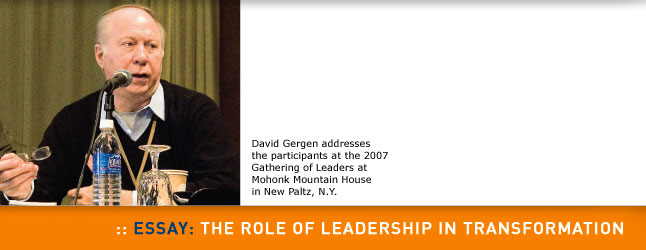
Essay: The Role of Leadership in Transformation
An article from Knight Foundation’s 2006 Annual Report
By David Gergen
It’s impossible to imagine the creation of India without Mohandas Gandhi’s leadership. Or the emergence of biracial harmony in a free South Africa without Nelson Mandela. Or the rallying of the British people to turn back the Nazi threat without Winston Churchill.
Coming closer to home, we cannot think of the creation of our own republic without remembering George Washington, or its survival without remembering Abraham Lincoln. Nor can we envision how so many hands would reach out to help residents of industrial cities without Jane Addams, or how the civil rights movement would have succeeded without Martin Luther King Jr.
The lesson is clear: Strong, effective, moral leadership is critical to transformations. Long before a leader steps forward, of course, social and economic forces may create an environment in which change becomes more possible; pressures for change may build up from the grassroots over a period of years. Ultimately, however, at least one individual must take a risk, pick up a banner and blow a trumpet, calling others to come together in the pursuit of a shared vision. That individual is the person we call a leader, and that leadership goes hand in hand with transformation.
We rightly salute individual leaders for their achievements, and since the days of ancient Athens, societies have sought better ways to prepare young people to become leaders. In our own time, we have learned to prize innovative and entrepreneurial leaders, whether they are building a business or starting a charter school. Today, as in the past, the quality of leadership remains the “X factor” in organizations and societies – that extra dimension that is hard to measure but that can make all the difference in whether a group succeeds in its mission.
Yet it would be a mistake to see a transformational leader as a singular, heroic figure atop a white horse, able to win the day all by himself. As Warren Bennis wrote some years ago, the old vision of the lone individual bending history has given way to an understanding that leadership is most frequently exercised within a group context.
Often, a group succeeds because there is not one but at least two co-leaders who guide the fortunes of the organization. Would Bill Gates have built Microsoft without Steve Ballmer at his side? Would Ben Bradlee have transformed The Washington Post without Katharine Graham? Or think of the success of the Knight brothers, as Jim managed the business side and Jack worked with the editors. Among the leading social entrepreneurs of today, few are more successful than Dave Levin and Mike Feinberg in building the KIPP (Knowledge Is Power Program) schools, or Alan Khazei and Michael Brown in building City Year. Partners in leadership can be an excellent recipe for transformations.
For the individuals who must lead without a partner, the key is to create a great team. The historian Doris Kearns Goodwin has shown us, for example, that Lincoln succeeded to a considerable degree because he chose such strong Cabinet members to help him and willingly sought their counsel. When Lou Gerstner went to the rescue of IBM, he was wary at first of setting a vision; he put far more emphasis upon assembling a strong team around him. Jack Welch was famous at General Electric for forming one of the strongest teams ever seen. As management scholar Jim Collins has written, one of the first tasks of a leader these days is to get the right people on the bus in the right seats – and get the wrong people off the bus.
Even a great team may fail, however, unless the leadership creates a special culture within the organization – a culture that is dedicated to a vision of change. Blowing a trumpet will be an empty exercise unless there are listeners willing and ready to respond. Thomas Jefferson once speculated that the reason the American Revolution succeeded while the French Revolution slid into tyranny was the difference in the quality of the followers – in America, people had become accustomed to governing themselves in small communities while in France, they had not. One group of followers was willing and prepared to build a democratic republic; the other was not.
In today’s context, to achieve transformation, the role at the top is to become a leader of leaders. The most effective leaders are those who push responsibility and leadership down into the organization, empowering people at the lowest levels to become leaders in their own right. Then you unleash the true transformative power of the whole team. And that culture will survive and even flourish long after an individual leader steps off the stage.
America today cries out for transformation. Even as we have accumulated massive economic and military power, we have squandered much of our respect in the eyes of the world. Here at home, we have drifted badly, failing to renew our public schools, allowing glaring inequalities to emerge in our communities, permitting the health-care system to weaken, piling up financial IOUs to our younger citizens, and recklessly spoiling the environment. Clearly, we need to transform our culture and our communities. It’s time not just for one or a hundred but for thousands upon thousands of new leaders to step forward, pick up the banner and blow the trumpet of change. Millions of Americans are now listening and are ready to act.
###
In the past three decades, David Gergen has served as White House adviser to Presidents Nixon, Ford, Reagan and Clinton. He was editor of U.S. News & World Report in the mid-1980s. He is a professor of public service and director of the Center for Public Leadership at Harvard’s Kennedy School of Government. He wrote this essay for Knight Foundation.